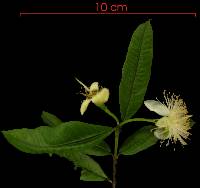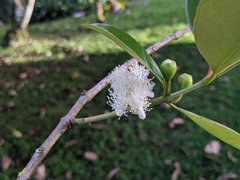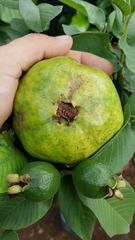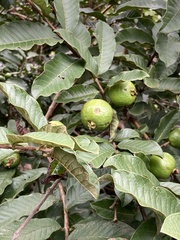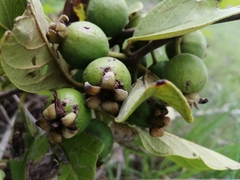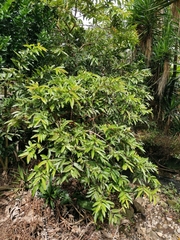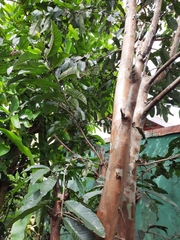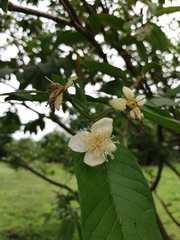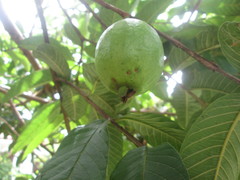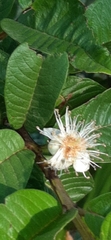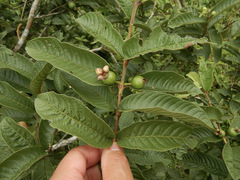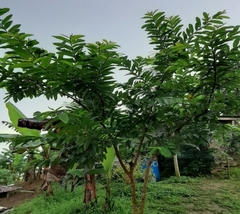

|
|
|
|
Family: Myrtaceae
Brazilian Guava, more...guava (es: Guayaba, guayabo)
|
Descripción: Árbol de 5 a 10 m de alto. Copa pequeña y dispersa. Tronco ramificado a baja altura. Corteza exterior marrón, exfoliante en láminas quedando lisa y de color blanco. Ramitas terminales cuadrangulares. Hojas simples y opuestas, de 6-14 x 3-6 cm, elípticas a oblongas, con ápice acuminado, bordes enteros y base obtusa o redondeada. Las hojas presentan pelos por el envés y tienen las nervaduras bulladas. Pecíolo de 0.3-0.8 cm de largo y ligeramente acanalado en la parte superior. Flores blancas con muchos estambres. Frutos en bayas globosas o en forma de peras, de 3-10 cm de largo, verdes y con una estructura en forma de corona en la punta, tornándose amarillos al madurar. Datos Ecológicos: La especie crece a bajas elevaciones, en lugares secos o húmedos. Común en pastizales y fincas de áreas secas de la vertiente del Pacífico en Panamá, pero rara o ausente en bosques lluviosos del Caribe. Florece y fructifica durante todo el año. Las flores son visitadas por abejas y otros insectos. Las semillas son dispersadas por animales. Especies Parecidas: A menudo se confunde con LK psidfr Psidium friedrichsthalianum LK2 , pero en P. friedrichsthalianum las hojas son de menor tamaño y no tienen las nervaduras bulladas. LK tripcu Triplaris cumingiana LK2 y LK termob Terminalia oblonga LK2 son árboles de mayor tamaño y con troncos muy parecidos, pero tienen hojas alternas. Usos: La madera es empleada en construcciones pesadas, puentes, pisos y postes de cercas. Los frutos son comestibles y con ellos se preparan jugos, mermeladas y jaleas. Shrub or small tree, to 5 (10) m tall, to 25 cm dbh; stems glandular-dotted; young stems, petioles, lower leaf surfaces, and midribs above densely short-pubescent. Petioles ca 5 mm long; blades oblong-elliptic, obtuse or apiculate at apex, obtuse to rounded at base, 7-12 cm long, 3.5-6 cm wide, glabrate in age, pellucid-punctate; lateral veins in 12 pairs or more, prominently raised. Flowers solitary in axils, 5-parted; pedicels 1-2 cm long; pedicel and outside of calyx short-pubescent; calyx lobes triangular, to 1 cm long, sericeous inside; petals ovate, white, 1.5-2 cm long, sparsely pubescent outside, glabrous inside; stamens numerous; style simple. Berries globose or pear-shaped, to 6 cm diam, green turning yellow-pink; seeds many. Croat 5299, 8385. Cultivated in the Laboratory Clearing; growing spontaneously on the shore at the end of Peña Blanca Peninsula and on Orchid and Slothia islands. Flowers in the dry season. The fruits mature in the late rainy season and the early dry season. Bocas Species Database Habitat: The Guava tree can tolerate different types of climate, except the ones where frost may occur. It can grow in different types of soil, such as sand, clay and acid to alkaline (pH from 4.5 to 8.2). The optimum rainfall is between 1,000 and 2,000 mm annually and excess in rainfall may reduce significantly the sugar content of the fruit. The ideal temperature for this tree varies between 23ºC and 28 ºC. Distribution: Guava is native to tropical America, but is now present in every tropical and subtropical country. Natural History Notes: Birds usually spread the seeds of the guava tree and cultivators in some countries have had problems to control its propagation and the quality of the seedlings. This is why commercial plantations have been trying to maintain a vegetative propagation for this tree. The new trees are usually planted at the beginning of the raining season. The best quality fruit is obtained when it ripens during the dry season. Characteristics: Guava is a small evergreen tree that belongs to the Myrtaceae family. One can easily recognizes it by its reddish-brown trunk that peels off to reveal the green layer underneath, and by the twigs that are quadrangular. The leaves have an opposite arrangement and an oval to elliptic shape. You can smell the aroma of the leaves if you crush them your hands. The flowers are white and show many stamens (male organ). The flowers emerge singly or in small clusters. The guava fruit is in fact a berry whose shape can vary from round to pear-shaped. The skin is yellow with some patches of pink and the interior of the fruit consists of a juicy central pulp dark-pink colored with several yellowish seeds. Notes: The ripe fruit of the guava can be eaten fresh or cooked. It is usually used to make jellies and jams and in Panama you can find guava in many pastries and other delicacies. The fruit is rich in vitamins A, B and C, and in other minerals. A single guava fruit contains more than twice the vitamin C of an orange! The seeds can be consumed and are rich in polyunsaturated fatty acids omega-3 and omega-6. The leaves are used to make decoctions to cure diarrhea and other stomach problems. Humans are not the only ones to appreciate guava; it is an important food sources for caterpillars, mammals and birds. |





